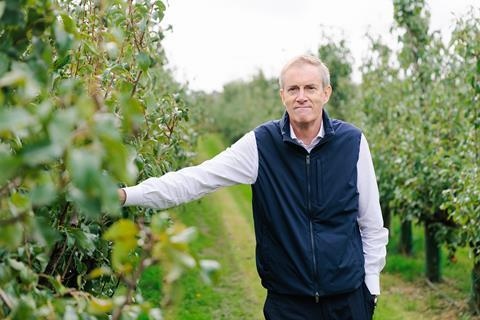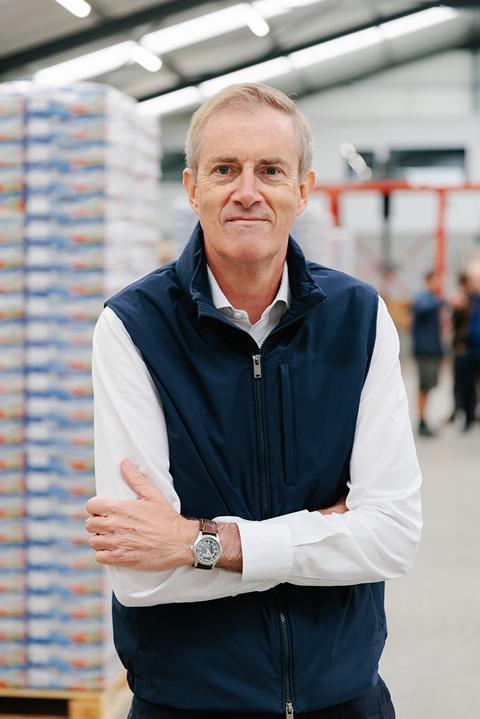Greater focus needed on taste and enjoyment to arrest declining consumption of Conference pears in Europe, says Marc Evrard, commercial director of Belgian Fruit Valley, with lessons to be learnt from Asia
How’s the new Conference pear crop looking in Belgium? Have weather conditions been a challenge so far this year?
Marc Evrard: Every season has its challenges. Obviously, this season is no different. It’s still one and a half months before we commence with our Conference pear harvest. There will be some Corina a few weeks earlier, but the main crop is Conference, and we predict harvesting to start around 20 August.
We have had some challenges, but we’ve had multifarious challenges over the past years, or the past decade even, so it’s difficult to predict what else may happen in the next couple of months.
We had a humid springtime, as well as abundant rainfall, which means that groundwater is up to the right level again, so there is ample water for the trees. This is excellent news for pears, although less good for cherries, which absorb all the water and can split and burst as a result.

What about the issue of heat? Parts of Europe are getting quite accustomed to a yearly heat wave…
ME: We actually could have done with a little more sunshine this year, but it also hasn’t been too hot. Finding the right balance is not so easy. We had some early hailstorms which affected a part of our production area. Fortunately this came quite early in the growing season, so we won’t see much of an effect later on.
We had quite a lot of fruit drop, so fewer pears to harvest. But the pears on the trees look good, so we expect a slightly smaller crop compared with last year’s bumper crop, but the quality is more important and looks good.
How this will be translated into volumes per hectare, we won’t know yet. If we have a lot of sunshine that would be great. But there’s still six weeks to go. If we are hit by another hailstorm or a heat wave it may change the situation, but things are looking good.
What are your expectations in terms of volumes?
ME: There will be a smaller crop from Belgium, as from The Netherlands. At Interpera, the figures for pears suggest a drop in volume of around 30 per cent. We think we will see a decline of around 20-25 per cent once the pears on the trees grow bigger and gain weight.
The important thing is we are still well positioned as a growing region in Belgium compared with other pear producing countries worldwide. We may have a toolbox of plant protection products that gets emptier each year, but we can rely a lot on the professionalism of our growers.
Is the issue of climate change becoming a bigger factor for pear growers?
ME: The weather always plays an important role. But all the climatic challenges we are facing are also being seen in other regions. And things like droughts, floods and frost seem to be worse elsewhere.
In Belgium, we are still producing an average of 40 tonnes per hectare. That is double the yield of Portugal, for example. We have around 10,000ha of production, so the volume stands at around 400,000 tonnes. Last year we had a big crop of 460,000 tonnes.
In Portugal, growers experienced a shortage of chilling hours in the wintertime, which resulted in a lower yield. It looks like some of these challenges may here to stay. It is the same in Italy, with volumes being much lower than a few years ago.
We also noticed that because of climate-related conditions, there is more pressure from diseases, including fireblight in Portugal, and stinkbug in Italy. In Spain, production has also been scaled back, especially in Lerida and Rioja. So Belgium will remain the main Conference growing region in Europe going forward.
How has the market been in Europe?
ME: What we’ve seen in the last 18 months has been very favourable in terms of returns for growers, at least until the last month or so. But we mustn’t rest on our laurels. A lot of effort is needed still. One season of good prices doesn’t mean it’s going to stay like that. We have been developing new marketing strategies and working on new markets, and this doesn’t happen overnight. No markets stay available by themselves, so the focus on quality and taste remains as important as ever.
Production is one thing, but the drop in pear consumption in Europe is another. If production drops by 10 per cent, the grower may see it as an opportunity for better prices, but If consumption drops by 20 per cent, then you have a problem of overproduction.
Careful analysis shows the decline in consumption is not because people don’t like eating pears anymore. They remain popular and are liked by young people as well as old. But in the last two seasons, the price has been relatively high, especially for Conference pears. At moments like this, consumers have a wide range of produce to choose from. If they can see nectarines in the summer at a much more attractive price than pears, then they will go for that.
However, in the years before this better price situation, growers were really struggling to break even. But in this challenging economic situation for consumers, a price hike of €0.60 a kilo can be intimidating for consumers. So we are aiming to boost consumption a little by emphasising even more the quality of the fruit, focusing on the taste when growing the fruit with enough sugars, and not artificially extending the seasons, but respecting the seasonality of the fruit.
We plan to expand our marketing activities, not just focusing on the health aspects of pears but also the taste. We eat fruit because it’s healthy, but equally because it’s nice to eat. Pears can be consumed in a variety of different ways, as a fresh fruit, but also in salads, desserts and pies, so we want to highlight this.

What about your markets outside Europe? Are you planning any campaigns?
ME: We are keeping up our marketing activities in our overseas markets, in Asia as well as in Latin America. In Asia, we are targeting all the main markets, and some new ones. China of course is a very big country. It has a big population and it is very well organised. Chinese consumers luckily buy on taste, and that’s a big part of our marketing. We still need to reach a lot more consumers. China remains a competitive market. You have new varieties of produce coming in all the time, be that pecans, durians or kiwifruit. There may be great demand for cherries around New Year, and then a couple of weeks later it’s all about lychees.
We are definitely interested in Vietnam and Thailand and also less affluent countries like Cambodia. There are also non-tariff trade barriers that restrict access. We are working on access to these markets, and simultaneously following up with marketing and commercial activities. We will have market access to the Thai market, but we have to ensure getting produce there is done in a workable way in terms of protocols and procedures. There’s no point working out access that is completely unworkable.
Are we able to learn from Asia in terms of how we boost consumption in Europe?
ME: The good thing about consumers in East Asia and also Latin America is they are very into their fresh produce, and fresh fruit in particular. They are likely to eat fresh fruit before or after a meal, and commonly snack on fruit in the street. That is a very interesting situation for fruit marketers like ourselves, and is encouraging to see. We want to support this mentality and this lifestyle.
It’s a lot to do with education. At kindergarten, we have to get kids eating fruit for enjoyment. It’s no good if the person taking care of the children says, “If you eat this portion of fruit, kids, then you can have a tasty chocolate bar!” That’s already giving them the wrong message.



